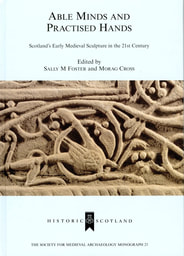Researching the condition of Alasdair McLeod's Tomb, Rodel, Harris. Crown copyright Historic Scotland
Research
Research — understanding what is significant about carved stones, and continuing to ask further questions — is fundamental to a sustainable future for carved stones. The NCCSS aims to encourage research on Scotland’s carved stones, in all their diversity, and publication in appropriate media targeted at a wide range of audiences.
In 2014/15, informed by its critical analysis of the issues facing carved stones, NCCSS contributed to the production of a Scottish Archaeology Research Framework for carved stones, part of the Future Thinking for Carved Stones project grant-aided by the Royal Society of Edinburgh and Historic Scotland (organised by Dr Sally Foster, University of Stirling and Dr Katherine Forsyth, University of Glasgow).
Previous NCCSS research initiatives:
The NCCSS has a long-standing track record in supporting carved stone research, with earlier initiatives including:
In 2014/15, informed by its critical analysis of the issues facing carved stones, NCCSS contributed to the production of a Scottish Archaeology Research Framework for carved stones, part of the Future Thinking for Carved Stones project grant-aided by the Royal Society of Edinburgh and Historic Scotland (organised by Dr Sally Foster, University of Stirling and Dr Katherine Forsyth, University of Glasgow).
- Future Thinking on Carved Stones in Scotland: a Research Framework by Dr Sally Foster, Dr Katherine Forsyth, Dr Susan Buckham and Dr Stuart Jeffrey aims to to link, inspire, mobilize and help direct the efforts of anyone with an interest in or responsibility for carved stones in Scotland. As well as an online wiki format the 2016 ScARF panel report can be download as two PDFs: the original text [5.4MB] and 39 Case Studies [2.8MB]
- Listen to the Stones by Dr Adrian Maldonado and Dr Susan Buckham is based on the original text above and provides a popular introduction to the carved stones ScARF
Previous NCCSS research initiatives:
The NCCSS has a long-standing track record in supporting carved stone research, with earlier initiatives including:
 Cover of Able Minds and Practised Hands, the proceedings of a conference sponsored by the NCCSS. Available to buy from http://maneypublishing.com/index.php/books/sma23/
Cover of Able Minds and Practised Hands, the proceedings of a conference sponsored by the NCCSS. Available to buy from http://maneypublishing.com/index.php/books/sma23/
- Able Minds and Practised Hands (2003, organised by Historic Scotland, NCCSS and The Society of Medieval Archaeology). Published as S Foster and M Cross (eds) 2005. Able Minds and Practiced Hands Scotland’s Early Medieval Sculpture in the 21st Century. Leeds: Maney
- St Andrews Sarcophagus (1997, organised by Historic Scotland and the Society of Antiquaries of Scotland.). Published as S Foster (ed) 1998. The St Andrews Sarcophagus: A Pictish Masterpiece and its International Connections. Dublin: Four Courts Press
- Conservation of Historic Graveyards (2001, organised by Historic Scotland and the Society of Antiquaries of Scotland)
- Post-Reformation Gravestones (1994, organised by NCCSS and The Society of Antiquaries of Scotland).
The NCCSS celebrates examples of research carried out by others that contribute to our shared knowledge and appreciation of carved stones.
Examples of good practice:
- Lest Scotland Forgets: University of Stirling’s ongoing project to create a database of Scottish war memorials.
Select bibliography:
- WELLS, G. BISHOP B., 2005. Researching Your Graveyard. Historic Scotland.
- GULLANE AND DIRLETON HISTORY SOCIETY, 2009. Life and Death in Dirleton Parish. A Social History Derived from Kirkyard Memorials. Gullane and Dirleton History Society.
- HISTORIC ENVIRONMENT SCOTLAND Iona Research Conference
- HYGEN, A., 2006. The Rock Art Project 1996 – 2005. Final Report from the Directorate for Cultural Heritage. Available from: Oslo: Riksantikvaren.
- PENMAN, M., ed, 2013. Monuments and Monumentality across Medieval and Early Modern Europe. Donington: Shaun Tyas.
- RITCHIE, A. (ed). 1994. Govan and its Early Medieval Sculpture. Stroud: Alan Sutton Publishing
- TARLOW, S., 1999. Bereavement and Commemoration: An Archaeology of Mortality. Wiley-Blackwell
- THOMSON, G., 2100. Lettering on Gravemarkers in Britain & Ireland. Dublin: Wordwell Ltd.
